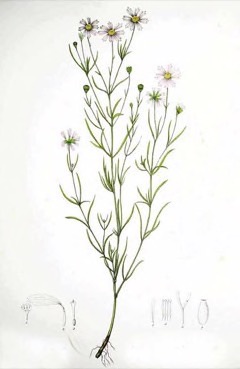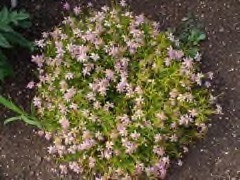 |
|
edibleplants.org |
 |
| F. D. Richards wikimedia.org |
Translate this page:
Summary
Physical Characteristics

 Coreopsis rosea is a PERENNIAL growing to 0.6 m (2ft) by 0.6 m (2ft in) at a fast rate.
Coreopsis rosea is a PERENNIAL growing to 0.6 m (2ft) by 0.6 m (2ft in) at a fast rate.
See above for USDA hardiness. It is hardy to UK zone 4.
Suitable for: light (sandy) and medium (loamy) soils. Suitable pH: mildly acid and neutral soils. It can grow in semi-shade (light woodland) or no shade. It prefers dry moist or wet soil.
UK Hardiness Map
US Hardiness Map
Synonyms
Calliopsis rosea (Nutt.) Spreng. C. rosea f. leucantha Fernald. C. rosea f. rosea.
Plant Habitats
Edible Uses
References More on Edible Uses
Medicinal Uses
Plants For A Future can not take any responsibility for any adverse effects from the use of plants. Always seek advice from a professional before using a plant medicinally.
None known
References More on Medicinal Uses
The Bookshop: Edible Plant Books
Our Latest books on Perennial Plants For Food Forests and Permaculture Gardens in paperback or digital formats.

Edible Tropical Plants
Food Forest Plants for Hotter Conditions: 250+ Plants For Tropical Food Forests & Permaculture Gardens.
More

Edible Temperate Plants
Plants for Your Food Forest: 500 Plants for Temperate Food Forests & Permaculture Gardens.
More

More Books
PFAF have eight books available in paperback and digital formats. Browse the shop for more information.
Shop Now
Other Uses
A good ground cover with medium to high density growing at a fast rate. Plants will spread in the garden by rhizomes and self-seeding to form a dense ground cover, sometimes to the point of being considered aggressive [368-1]. Ornamental: Long summer bloom and airy foliage provide good accent in borders or rock gardens. Good small area ground cover. Also effective as an edger for borders, foundations and walks/paths. Naturalized areas, native plant gardens or cottage gardens [368-1]. Wildlife Food: Attracts birds that eat the seeds. Insectory: Provides for food for pollinators [1-2]. A good cut flower.
Special Uses
Food Forest Ground Cover
References More on Other Uses
Cultivation details
An herbaceous perennial for temperate areas. USDA Hardiness Zones: 4 - 9. Soil pH: 6.6 - 7.8.Growth Rate: Moderate. Life Span: Long-Lived Perennial. Stand Persistence: Long. Form: Creeping. Texture: Fine. Sun: Full Sun, Partial Shade. Soil Type: Sandy, Loamy, Silty. Soil Moisture: Wet, Moderate. Root Type: Rhizome. Seasonal Interest: Summer-Fall. Spreads via rhizome and seeds, can be aggressive. Seeds resemble ticks, hence the name tickseed. Fruit is a cypsela. Flower Color: Pink, Yellow. Drought: Sensitive. Flood: Sensitive. Salt: Moderate [318-1]. Bloom Time: Early Summer - Early Fall. Fruit Time: Summer - Fall. For polyculture design as well as the above-ground architecture (form - tree, shrub etc. and size shown above) information on the habit and root pattern is also useful and given here if available. The plant growth habit is a runner spreading indefinitely by rhizomes or stolons [1-2]. The root pattern is fibrous dividing into a large number of fine roots [1-2]. The root pattern is stoloniferous rooting from creeping stems above the ground [1-2].
References Carbon Farming Information and Carbon Sequestration Information
Temperature Converter
Type a value in the Celsius field to convert the value to Fahrenheit:
Fahrenheit:
The PFAF Bookshop
Plants For A Future have a number of books available in paperback and digital form. Book titles include Edible Plants, Edible Perennials, Edible Trees,Edible Shrubs, Woodland Gardening, and Temperate Food Forest Plants. Our new book is Food Forest Plants For Hotter Conditions (Tropical and Sub-Tropical).
Shop Now
Plant Propagation
Sow seeds at 55° to 61°F in mid- or late winter, or divide plants in early spring. Basal cuttings can be rooted in spring.
Other Names
If available other names are mentioned here
Pink coreopsis, Pink threadleaf coreopsis
Native Range
NORTHERN AMERICA: Canada, Nova Scotia, United States, Massachusetts, New Jersey, Pennsylvania (east), Rhode Island, Delaware,
Weed Potential
Right plant wrong place. We are currently updating this section.
Please note that a plant may be invasive in one area but may not in your area so it's worth checking.
None Known
Conservation Status
IUCN Red List of Threatened Plants Status :

Growth: S = slow M = medium F = fast. Soil: L = light (sandy) M = medium H = heavy (clay). pH: A = acid N = neutral B = basic (alkaline). Shade: F = full shade S = semi-shade N = no shade. Moisture: D = dry M = Moist We = wet Wa = water.
Now available:
Food Forest Plants for Mediterranean Conditions
350+ Perennial Plants For Mediterranean and Drier Food Forests and Permaculture Gardens.
[Paperback and eBook]
This is the third in Plants For A Future's series of plant guides for food forests tailored to
specific climate zones. Following volumes on temperate and tropical ecosystems, this book focuses
on species suited to Mediterranean conditions—regions with hot, dry summers and cool, wet winters,
often facing the added challenge of climate change.
Read More
Expert comment
Author
Nutt.
Botanical References
Links / References
For a list of references used on this page please go here
Readers comment
| Add a comment |
|
If you have important information about this plant that may help other users please add a comment or link below. Only comments or links that are felt to be directly relevant to a plant will be included. If you think a comment/link or information contained on this page is inaccurate or misleading we would welcome your feedback at [email protected]. If you have questions about a plant please use the Forum on this website as we do not have the resources to answer questions ourselves.
* Please note: the comments by website users are not necessarily those held by PFAF and may give misleading or inaccurate information.
To leave a comment please Register or login here All comments need to be approved so will not appear immediately.
|
Subject : Coreopsis rosea
|
|
|
|